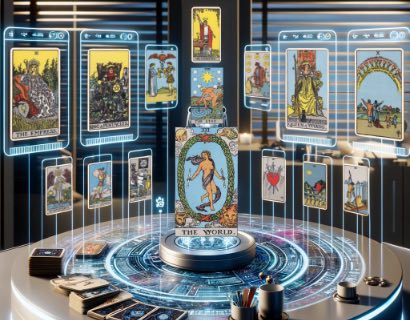|
Deck: The Short Hand Tarot
by Markus Pfeil. |
Created on Phuture Me |
Also available in our Tarot & Numerology App for Apple iOS & Android
 |
 |
Screenshot
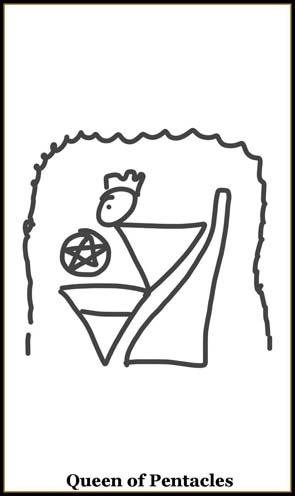
Court cards, like the Queen of Pentacles, are unnumbered which makes using numerology to unlock their basic symbology a trickier exercise. On the surface we have the female ruler of the elemental domain of Earth but not much else to go on. We can, however, link Tarot's Queens to their supreme ruler and card number 3 of the Major Arcana, The Empress, which would give any Queen a numerological attribute of 3 by proxy.
The same element and numerology is found in the 3 Of Pentacles with its artisan creating something of material value appreciated by others.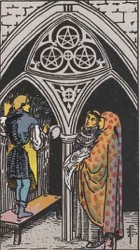 These cards are linked because the Queen of Pentacles is the patron of the artisan. She appreciates and loves the fine products created by artisans and uses her wealth to support, nurture and enjoy their creations.
These cards are linked because the Queen of Pentacles is the patron of the artisan. She appreciates and loves the fine products created by artisans and uses her wealth to support, nurture and enjoy their creations.
Comparing The Rider-Waite-Smith (RWS) Deck's Queen of Pentacles to The Empress it's difficult to see which is wealthier or in the better place. Both are richly dressed and sitting in bountiful gardens with plenty of sun and water. No wind or storms disturb either domain, all their elements are in harmony. Which one looks the most content? The importance of observing a Tarot character's focus, and mindfulness (or lack of), is well illustrated by comparing these two. The Empress looks very content with her mind and attention in the present. The Queen of Pentacles, facing left or west, is lost in the past. Her head is bowed facing the ground. She looks at the pentacle in her lap and the earth below her feet. This isn't someone who is content or happy but probably someone who has achieved material success and has nothing left to do but admire the trophies of her past patronages and acquisitions.
The Queen of Pentacles, also known as the Queen of Coins or Queen of Deniers, can be wealthy, materially orientated and sometimes unpleasantly money minded. This person may be cautious, stubborn, materialistic, business minded or a good negotiator. As the element of earth also refers to physical health, or ailments, this person could be very athletic, careful with their body and perhaps even quite proud of it too. This could be someone who works out regularly and takes care with what they eat. Her vocation in life may be related to the element of earth. She could be a business woman, banker, accountant, tax advisor/collector, personal trainer or health professional.
© Phuture Me Ltd 2010-2019. All rights reserved.
THE PICTORIAL KEY TO THE TAROT
By Arthur Edward Waite (1911)
The face suggests that of a dark woman, whose qualities might be summed up in the idea of greatness of soul; she has also the serious cast of intelligence; she contemplates her symbol and may see worlds therein. Divinatory Meanings: Opulence, generosity, magnificence, security, liberty. Reversed: Evil, suspicion, suspense, fear, mistrust.
Related Tarot Cards
 |
 |
 |
 |
© Phuture Me Ltd 2018. All rights reserved.
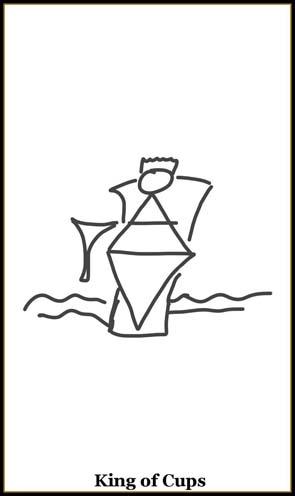
Court cards, like the King of Cups, are unnumbered which makes using numerology to unlock their basic symbology more challenging. On the surface we have the male ruler of the elemental domain of Water but not much else to go on. We can however link Tarot's Kings to their supreme ruler and card number 4 of the Major Arcana, The Emperor, which would give any King a numerological attribute of 4 by proxy.
The same element and numerology can be found in the 4 of Cups. The Rider Waite Smith (RWS) deck first illustrated the 4 of Cups as a young male, arms and legs crossed defensively, sitting under a tree looking petulantly at 3 cups before him. Like the Ace of Cups there is a cloud with a hand offering a new, 4th, cup.  Perhaps past relationship issues have left this emotionally inexperienced youth guarded about engaging in any new relationships. The number 4 is symbolic of a rigid structure which is static and safe but its unchanging form can be also be stagnant and boring. In the 4 of Cups we see someone who is unwilling to accept the next emotional step on from the care free 3 Of Cups to a stable and lasting relationship offered by the 4th cup. The RWS deck's King of Cups faces front with his head turned to the right, or east, representing the future. He sits in a safe and secure place on a throne on a solid, square, rock surrounded by a rough sea. His right foot forward almost as if he's prepared to "dip a toe in the water". The attitudes displayed in these two cards are contrastingly different with the youth reluctant to engage with 4 cups of water and the King unafraid of a vast, stormy sea.
Perhaps past relationship issues have left this emotionally inexperienced youth guarded about engaging in any new relationships. The number 4 is symbolic of a rigid structure which is static and safe but its unchanging form can be also be stagnant and boring. In the 4 of Cups we see someone who is unwilling to accept the next emotional step on from the care free 3 Of Cups to a stable and lasting relationship offered by the 4th cup. The RWS deck's King of Cups faces front with his head turned to the right, or east, representing the future. He sits in a safe and secure place on a throne on a solid, square, rock surrounded by a rough sea. His right foot forward almost as if he's prepared to "dip a toe in the water". The attitudes displayed in these two cards are contrastingly different with the youth reluctant to engage with 4 cups of water and the King unafraid of a vast, stormy sea.
The key difference between the youth in the 4 of Cups and the King of Cups is emotional maturity. The King has the benefit of experience and is unafraid of the wild and deep emotional waters of life. He represents an emotionally experienced, well balanced and socially confident person. A shoulder to cry on, a patient listener and sympathetic ear. Sensitive and understanding this person would make a good counsellor. Unlike the youth this King is not afraid of emotional commitment and long term, lasting, relationships. This is what he is good at and he represents someone who would make a great husband, partner, father or friend.
The King of Cups may represent a mature* man whose vocation in life is related to the element of water (a fisherman, sailor, plumber etc.) or emotions (a counsellor, psychologist, actor etc). The symbolic relationship to this card may not be vocational. It could be a description of his personality. In this case this man will be a sensitive, caring, patient and perhaps even a gullible or innocent man. Sometimes it refers to a man who has feminine qualities or is highly intuitive or even psychic.
*maturity happens between ages 28 to 37, when a man enter's his 2nd numerological life cycle.
© Phuture Me Ltd 2010-2019. All rights reserved.
THE PICTORIAL KEY TO THE TAROT
By Arthur Edward Waite (1911)
He holds a short sceptre in his left hand and a great cup in his right; his throne is set upon the sea; on one side a ship is riding and on the other a dolphin is leaping. The implicit is that the Sign of the Cup naturally refers to water, which appears in all the court cards. Divinatory Meanings: Fair man, man of business, law, or divinity; responsible, disposed to oblige the Querent; also equity, art and science, including those who profess science, law and art; creative intelligence. Reversed: Dishonest, double-dealing man; roguery, exaction, injustice, vice, scandal, pillage, considerable loss.
Related Tarot Cards
 |
 |
 |
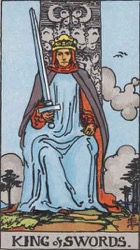 |
© Phuture Me Ltd 2018. All rights reserved.

In beginning to understand the meaning of this card let us begin with its name. The names assigned to some cards in the tarot deck can often mislead, or misdirect, from what the true meaning of the card is. The name is probably the place we start from before we even begin to take in what the picture is telling us. The Fool automatically makes us judgemental towards its character. The Lovers suggests a sexual context when it is really about choices and irreversible decisions. So begin by asking yourself what does the word World mean to you? Do you think of planet Earth as the World? Or do you consider it to encompass the entire Universe? We talk about heaven and earth as the two distinct planes of the spiritual and material. Do you consider The World to embody the latter or both? The word comes from the old German meaning "Age of Man" or "Domain of Man". However the Latin equivalent mundus, from which this Tarot card's original Italian name Il Mondo comes from, means "clean, elegant". The Latin word borrowed from the Greek word Cosmos meaning "orderly arrangement" the opposite, in Greek, being "Chaos". It was Pythagoras who first used the word Cosmos to describe the Universe.
Some modern decks have incorporated, in the background of this card, an image of planet Earth. The Rider Waite Smith (RWS) deck changed most of the cards in Tarot but not this one, A.E Waite described the card as "unchangeable". Traditional tarot decks, including the RWS, depict this card as a woman standing, or dancing, inside a oval laurel which symbolises a Yoni, womb or female reproductive organs. This detail may suggest a meaning of birth, re-birth or fertility.
The World and The Empress are connected through numerology as both are 3s. As card 21 of the Major Arcana its numerology is 3 when 21 is reduced (2 + 1 = 3). Both cards relate to fertility and nurturing but with The World this isn't so focused on the physical and material as The Empress, but on the spiritual and divine. There is one other 3 in the Major Arcana which shares a visual detail. Notice in the traditional depictions, including the RWS deck, that the woman in The World has her left leg crossed behind her right leg. This same detail is found in card 12 of the Major Arcana The Hanged Man. This crossed legs is an ancient symbol known as a fylfot in the West and swastika in the East. This is not a symbol of hate, as it was mis-used in the middle of the 20th century, but an ancient and sacred symbol of the eternal wheel of life. In India it is a symbol of health, luck, success and prosperity and in Europe it can be found in the stained glass windows of some churches. If The World represents a womb and birthing then The Hanged Man would represent a child coming head first from it. Both cards together would be a good omen for an expectant mother worried about the birth.
In the RWS deck the character's body indicates motion to the right, or west, symbolising heading in the right direction. Compare this to The Fool, in the same RWS deck, who is heading in the wrong direction. The World character looks over her shoulder, in a mirror image of the thief in the 7 of Swords. The thief is heading in the wrong direction looking over his shoulder towards the future and correct direction. The World character is looking back at the past, at the road she has travelled. This is an important detail as The World often symbolises being in a better position to make decisions with the benefit of experience. If it is the final outcome card, in a tarot spread, it could mean that you may change your opinion on something, or someone, when you reach the end of that cycle or situation. Like climbing to the top of a hill or mountain, to get a better view of the surrounding landscape, your situation needs you to be in a better position to fully understand it.
The final visual detail in The World is a biblical one. In each corner of the card, seen in the traditional decks and the RWS, is a face of the "four living creatures" Ezekiel describes in the old testament (Ezekiel 1:1-10) . They are also described in John's vision in Revelation (4:6–8) as sitting around the throne in heaven. These four characters are also found in the The Wheel of Fortune card of the RWS deck. Some consider The Fool to represent our struggles through life, and the many trials we must learn from, culminating in a final Judgement before attaining heaven, ascension, enlightenment or re-birth represented by The World. In a non-spiritual interpretation of this card it may mean successfully reaching a finishing line and completing something.
"The Lama Ngawang Kalzang had been meditating for twelve years in various caves and retreats in the wilderness of the mountains of Southern Tibet ..... The world had forgotten him, and he had forgotten the world. This was not the outcome of indifference on his part but, on the contrary, because he had ceased to make a distinction between himself and the world. What actually he had forgotten was not the world but his own self, because the ‘world’ is something that exists only in contrast to one’s own ego." - from "The Way of the White Clouds" by Anagarika Govinda
The World can symbolises completion, accomplishment, victory, travel overseas and expansion of horizons. A happy card to find in any spread it is the final card of the major arcana and therefore symbolic of the end of the journey of The Fool through all 21 major cards. It represents an ultimate goal achieved, a pinnacle in life. In its simplest interpretation this card may point to travel abroad to other continents, environmentalism or world affairs, or even simply travel documents such as a passport. As a person it could represent a foreigner. This card also symbolises fertility and reproductive organs.
And Heaven in a wild flower
Hold infinity in the palm of your hand
And eternity in an hour."
- William Blake
© Phuture Me Ltd 2010-2019. All rights reserved.
THE PICTORIAL KEY TO THE TAROT
By Arthur Edward Waite (1911)
As this final message of the Major Trumps is unchanged--and indeed unchangeable--in respect of its design, it has been partly described already regarding its deeper sense. It represents also the perfection and end of the Cosmos, the secret which is within it, the rapture of the universe when it understands itself in God. It is further the state of the soul in the consciousness of Divine Vision, reflected from the self-knowing spirit. But these meanings are without prejudice to that which I have said concerning it on the material side.
It has more than one message on the macrocosmic side and is, for example, the state of the restored world when the law of manifestation shall have been carried to the highest degree of natural perfection. But it is perhaps more especially a story of the past, referring to that day when all was declared to be good, when the morning stars sang together and all the Sons of God shouted for joy. One of the worst explanations concerning it is that the figure symbolizes the Magus when he has reached the highest degree of initiation; another account says that it represents the absolute, which is ridiculous. The figure has been said to stand for Truth, which is, however, more properly allocated to the seventeenth card. Lastly, it has been called the Crown of the Magi.
Related Tarot Cards
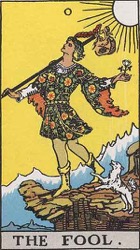 |
 |
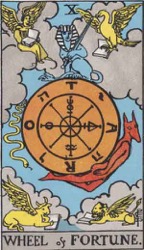 |
 |
© Phuture Me Ltd 2019. All rights reserved.
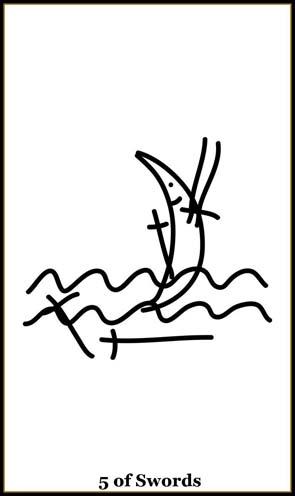
The 5 of Swords is a card of an empty and pointless victory, embarrassing or humiliating situations, quarrels and even violence. 5s are never welcome cards in any tarot reading and Swords are often troublesome. This card especially is a warning not to be taken lightly. In the Rider Waite Smith (RWS) deck the imagery is one of the aftermath of a battle. The victor picking at the remains. The defeated have turned their backs and walked away. This is a man without friends. There's no real prize here for anyone and the bleak landscape and grey sky sums up the mood of despair for all. What was the purpose of the fight? To strengthen an ego hell bent on it's desperate need to be right? The pitfall of being viewed as sanctimonious? This tragedy could have been avoided through diplomacy, listening to what others have to say, accepting differing opinions and searching for, and reaching, common ground.
The RWS 5 of Swords scene is the aftermath of a quarrel with one person looking very self satisfied and the other two, backs turned, leaving the scene. There are no friends here, no unity, only loneliness and despair. Too often we allow our views of the world, our identities, our religious or political beliefs to drive a wedge between us. By placing less value and priority on these abstract mental constructs we can build bridges between us and create harmony for all.
All the cards in the Minor Arcana numbered 5 are problematic cards. The number 5, in numerology, has the negative qualities of being chaotic, unstable, self-indulgent, irresponsible or careless and Tarot's Minor 5s reflect those negatives. If we look to the 5s in the Major Arcana we find positive cards which offer a solution to this chaos. Card number 5 of the Major Arcana is The Hierophant which represents conformity, doctrine, laws and rules that bring order from chaos. It represents not just the church and religious law but all establishments of authority which people live and work under. The other 5 in the Major Arcana is card number 14 Temperance (numerology reduces 14 to 5) which represents self control. When dealing with the 5 of Swords in a Tarot spread these additional cards maybe the warning, or the solution, of what sort of control will be applied to the unruly behaviour of this card. External control or self control.
The central character in the RWS 5 of Swords holds 3 swords symbolising the numerological link to the 3 Of Swords, the card of despair and heart ache. The 2 remaining swords on the ground are a numerological link to the 2 Of Swords symbolising the ignored diplomatic option which could have prevented this situation from occurring. They also serve as a link to Judgement and Justice in the Major Arcana. Both cards have numerological values of 2 and this symbolic connection may carry a warning of the consequences of his actions.
The Suit of Swords, representing the Element of Air, symbolises the mental and intellectual aspects of life. The storms on the path of life that we have to apply our minds and intelligence to navigate through. Like the steel in the sword we are tempered by the hammer and flames of life's challenges and trials. The negative characteristics and meaning of the number 5, in numerology, are instability, chaos, self-indulgence, irresponsibility, procrastination, thoughtlessness and carelessness. This combination of element and numerology would suggest not focusing on doing one thing well but many things badly. Not thinking things through properly and being forceful in gaining the upper hand, or short term victory, only for it to later turn against you into isolation, defeat and humiliation.
© Phuture Me Ltd 2010-2019. All rights reserved.
THE PICTORIAL KEY TO THE TAROT
By Arthur Edward Waite (1911)
A disdainful man looks after two retreating and dejected figures. Their swords lie upon the ground. He carries two others on his left shoulder, and a third sword is in his right hand, point to earth. He is the master in possession of the field. Divinatory Meanings: Degradation, destruction, revocation, infamy, dishonour, loss, with the variants and analogues of these. Reversed: The same; burial and obsequies.
Related Tarot Cards
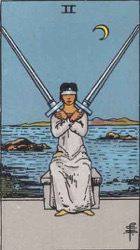 |
 |
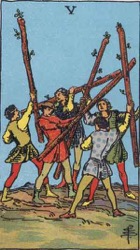 |
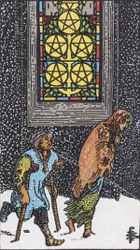 |
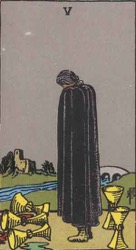 |
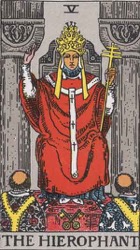 |
 |
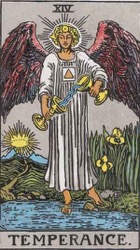 |
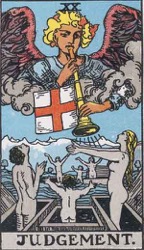 |
© Phuture Me Ltd 2018. All rights reserved.
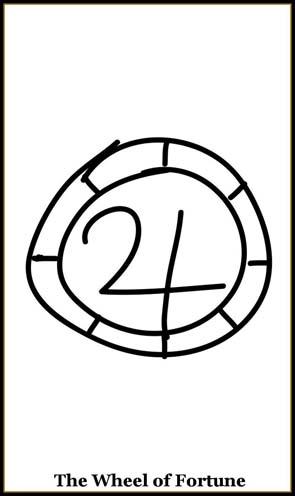
The number 10 marks the beginning of a new cycle after the completion of an old one. In numerology 10 reduces to 1 (1+0=1) which connects it to Tarot's Aces and The Magician. What makes it different is that it begins on top of a preceding cycle whereas the cards numbered 1 symbolise a fresh start with no history or carry over. Therefore The Wheel of Fortune marks a new beginning for something that is already part of your life. Compare The Wheel of Fortune to the 10s of the Minor Arcana which symbolise a new cycle beginning on the foundations of one, or many, previous cycles of their element. In the 10 Of Pentacles this is collective wealth, accumulated over generations of gathering material possessions, beginning a new cycle. Natural cycles are always different. No two years are ever the same. This is why this card is named Wheel of Fortune because the wheel is cyclic and each cycle, each rotation of it, will bring different fortunes, luck, challenges, defeats and success.
The Rider Waite Smith (RWS) deck uses a mixture of Egyptian, Graeco-Roman and Christian symbolism in its depiction of The Wheel of Fortune. In each of the four corners of the card are the "four living creatures" Ezekiel describes in the old testament (Ezekiel 1:1-10) . They are also described in John's vision in Revelation (4:6–8) as sitting around the throne in heaven. Smith and Waite included the same four characters in the corners of The World card of their RWS deck. In The World they symbolise reaching heaven, ascension or enlightenment. In the The Wheel of Fortune they symbolise the notion that one's fate is dictated by Divine Providence. The Wheel is inscribed with two words, their letters inter-changing. "TARO" and the Hebrew "יהוה" (or YHWH in Latin) which Waite states is the "Divine Name" ie the name of God. The world "TARO" can also be read as "ROTA" from the Latin for "wheel". The Sphinx sitting on top of the wheel is a guardian of sorts to balance the inclusion of the serpent on the left and Typhon below the wheel. Typhon is Greek mythology's equivalent to the Christian Devil. A monstrous deity who tried to over throw Zeus and failed only to be cast down and buried under a volcano. The inclusion of these characters is probably to symbolise the unpredictable and chaotic influences that make each cycle of the wheel different.
The Wheel of Fortune symbolises a feeling of something being different about familiar routines or habits. Like beginning a new year at school you are in the same place but a year ahead, studying more advanced subjects with different teachers and timetables. Your failures or successes from the previous year will no doubt play a part in how this year begins. Fate and destiny will also play a part of how this new cycle starts and unfolds. You have to prove yourself once more and there is no guarantee that this cycle will be a repeat of the last one as your fortunes can rise or fall. A simple interpretation of this card can be gambling, or taking a chance.
© Phuture Me Ltd 2010-2019. All rights reserved.
THE PICTORIAL KEY TO THE TAROT
By Arthur Edward Waite (1911)
In this symbol I have again followed the reconstruction of Éliphas Lévi, who has furnished several variants. It is legitimate--as I have intimated--to use Egyptian symbolism when this serves our purpose, provided that no theory of origin is implied therein. I have, however, presented Typhon in his serpent form. The symbolism is, of course, not exclusively Egyptian, as the four Living Creatures of Ezekiel occupy the angles of the card, and the wheel itself follows other indications of Lévi in respect of Ezekiel's vision, as illustrative of the particular Tarot Key. With the French occultist, and in the design itself, the symbolic picture stands for the perpetual motion of a fluidic universe and for the flux of human life. The Sphinx is the equilibrium therein. The transliteration of Taro as Rota is inscribed on the wheel, counterchanged with the letters of the Divine Name--to shew that Providence is imphed through all. But this is the Divine intention within, and the similar intention without is exemplified by the four Living Creatures. Sometimes the sphinx is represented couchant on a pedestal above, which defrauds the symbolism by stultifying the essential idea of stability amidst movement.
Behind the general notion expressed in the symbol there lies the denial of chance and the fatality which is implied therein. It may be added that, from the days of Lévi onward, the occult explanations of this card are--even for occultism itself--of a singularly fatuous kind. It has been said to mean principle, fecundity, virile honour, ruling authority, etc. The findings of common fortune-telling are better than this on their own plane.
Related Tarot Cards
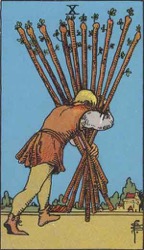 |
 |
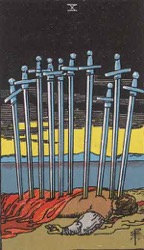 |
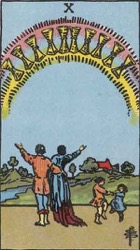 |
 |
© Phuture Me Ltd 2019. All rights reserved.
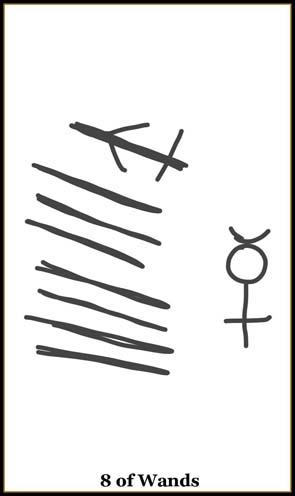
In the 8 of Wands tarot card we have a mix of some very powerful symbology. The Suit of Wands, and its element of Fire, symbolises energy, passion and drive. It is the fire that burns in the home and within the engines of our transport and industry. In numerology the number 8 gives you a "can do, will do" energy and ambition. It puts you in control with the focus to get things done. Not only the ambition but also the direction and resources to manifest goals. Combining the number 8 with the element of fire it would be perfectly correct for a 21st century tarot card to have a picture of a space rocket for the 8 of Wands. Or less dramatic, a cup of very strong coffee!
The Rider Waite Smith (RWS) deck was published at the turn of the 20th century only 6 years after the Wright Brothers achieved the first flight. Had Pamela C. Smith illustrated her deck 100 years later it may well have been a space rocket she would have used. Instead she illustrated what is probably the simplest card in her deck showing 8 wands flying together through the air over a simple, green, countryside. Smith uses the same background from her Ace of Wands but seen from a different perspective. In the Ace things have just started with a single wand being held upright by a hand. In the 8 of Wands things have progressed, multiplied, and are really moving on their own with no hands and no people. The 8 of Wands is the only card in the RWS deck not to feature a character or an additional prop. The The Wheel of Fortune has its Greek, Egyptian and biblical creatures and the 3 Of Swords has its sword pierced heart. The 8 of Wands has nothing other than a simple background and 8 flying wands.
When illustrating a Tarot card there is a danger of influencing the deck user too much by depicting an overly elaborate story which distracts users from the basic symbology. A good Tarot deck should have cards that remain open and fluid to interpretation. To become proficient in Tarot you must always be aware of what is missing as well as what is being presented to you. Smith's decision to exclude any characters, or props, from only this card may have been to emphasise the point that this card relates to forces that have already been set in motion and are out of anyones control. Like arrows that are already in flight one can only wait and see where it is they land, if they hit their target and what damage they do if any.
The 8 of Wands, 8 of Rods or 8 of Batons, is a card symbolising swift action, travel and expansion. The element here is Fire which relates to home, community, work and projects. The aspects of the number 8 in numerology are power, control, ambition, organisation, practicality, focus and success. This card is more commonly depicted as 8 wands flying through the air. This may have the metaphorical meaning of things changing swiftly and for the better. Its meaning can also be literal and the appearance of this card could indicate travel by air in the future.
© Phuture Me Ltd 2010-2019. All rights reserved.
THE PICTORIAL KEY TO THE TAROT
By Arthur Edward Waite (1911)
The card represents motion through the immovable-a flight of wands through an open country; but they draw to the term of their course. That which they signify is at hand; it may be even on the threshold. Divinatory Meanings: Activity in undertakings, the path of such activity, swiftness, as that of an express messenger; great haste, great hope, speed towards an end which promises assured felicity; generally, that which is on the move; also the arrows of love. Reversed: Arrows of jealousy, internal dispute, stingings of conscience, quarrels; and domestic disputes for persons who are married.
Related Tarot Cards
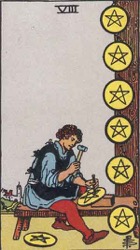 |
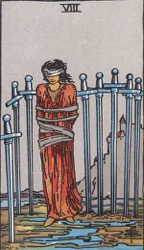 |
 |
 |
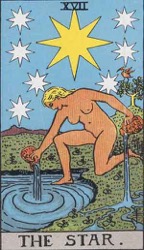 |
© Phuture Me Ltd 2019. All rights reserved.

The Rider-Waite-Smith (RWS) deck depicts the 4 of Pentacles as a minor, modestly dressed, king hoarding 4 pentacles, or coins. He sits on a stone box with a town or city visible in the background. The 4 of Pentacles is the bankers card where wealth is stored and safely guarded. The wealth that is stored there belongs to the King Of Pentacles. This RWS card is an unusual card for two reasons.
The first reason is because the Tarot deck contains only 4 Kings and 1 Emperor but the artist chose to add an additional king in this card. There is also a king in the Death card, lying dead on the ground, because the Kings and The Emperor are linked to Death through their numerological symbolism of the number 4 (Death is 13 which reduces to 4. 1 + 3 = 4). This connection between death and wealth may refer, on rare occasions, to an inheritance.
The second reason is because this character is looking directly at you with his attention in the present moment. This is a rare feature for a minor arcana card as it can only be found in the King Of Swords and the 9 Of Cups where as in the Major Arcana approximately half of the cards in that suit have this symbolism of present moment attention and contentment. Therefore the symbolism portrayed by the king's attention in the 4 of Pentacles is one of being happy with what you have materially even though it is just a modest amount.
The negative aspects of the 4 of Pentacles are depicted in this minor king having each foot on a pentacle embossed coin while tightly clutching one to his chest with both arms. This contentment with your material wealth makes you unwilling to invest, spend or share any of it. This is a stagnant situation which doesn't allow for growth or change. A common trait of the number 4 and part of the symbology of the Kings, the Emperor and Tarot's Death card. If something stagnates, and stops growing and evolving, it risks death and extinction. Life is cyclic and constantly changing, death breaks cycles. As you browse through the cards in the Suit of Pentacles notice how the wealthy and materially prosperous cards are set in rich gardens or lands. The cards without wealth have little or no plant life to be seen and it is in this category the 4 of Pentacles falls.
The 4 of Pentacles, or the 4 of Coins, is a card of financial security, stubbornness, greed and inflexibility. The element here is Earth which relates to wealth and material possessions. The aspects of the number 4 in numerology are security, patience, endurance, restriction, hard work, and rigidity. The 4 is thought of in many cultures as an unlucky number and this card's appearance would not be a good long term omen for personal wealth. Nothing is coming into the bank and although it may seem prudent not to spend in these circumstances it is preventing investment for the future.
© Phuture Me Ltd 2010-2018. All rights reserved.
THE PICTORIAL KEY TO THE TAROT
By Arthur Edward Waite (1911)
A crowned figure, having a pentacle over his crown, clasps another with hands and arms; two pentacles are under his feet. He holds to that which he has. Divinatory Meanings: The surety of possessions, cleaving to that which one has, gift, legacy, inheritance. Reversed: Suspense, delay, opposition.
Related Tarot Cards
 |
 |
 |
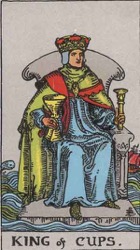 |
 |
© Phuture Me Ltd 2018. All rights reserved.
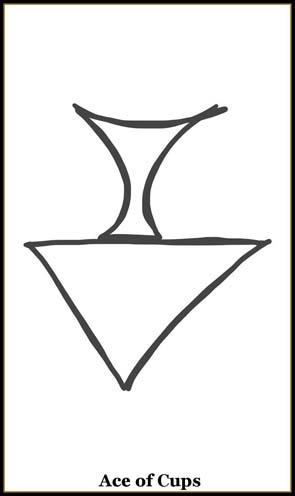
Aces are like plant seeds. These small, self contained, capsules can bring forth something new and, with a bit of luck, the right environment, nurturing and maintenance, can continue to grow and last for many seasons and years. Some don't grow at all and fail early. Some don't turn out as hoped and should be discarded to free space for growing something better. The Ace of Cups can be thought of as an emotional seed. Just as every seed is different so too is every appearance of the Ace of Cups. This card could signify a new friendship which maybe be short lived or may last a life time. It could be a new love interest but not one that progresses as far as a date and is unrequited. Or it may turn into a relationship or platonic friendship. With Aces, just like seeds, you really don't know how it is going to turn out until you try to grow it. All you know is that you have the potential to grow something new.
Numerology isn't well known or understood but there is no need to explain what the number 1 symbolises to most people. It is the number of a winner, a leader. It is premium and premier. These are the desired traits we all easily associate with 1 but we must remember that 1 is also symbolic of a beginning, a first step in a sequence, cycle or journey. It can also symbolise independence and individualism and with the Ace of Cups this would be emotional independence.
The Rider Waite Smith (RWS) deck added a lake covered with lily pads as a background to the Ace of Cups and included a hand, holding the cup, coming out of a cloud hovering over the ground. The Lily is symbolic of chastity and purity. The inclusion of the cloud, as the source of the hand, is there to symbolise the divine origin of all things. It serves to remind us of the greatest mystery of all - where does everything come from, and return to, including ourselves?
The Ace of Cups is traditionally represented as a single vessel filled with water. Its symbology is simple, it has the element of water and a numerological value of 1. As a 1 it represents a new beginning and, with water as the element, this beginning is an emotional one. The card more commonly heralds the coming of a new acquaintance or friend. Since 1's are, in numerology, singular it is less likely to signify a romantic relationship but not impossible. This card is about an individual emotional connection which may not be reciprocated. There are other cards which are more strongly associated with romantic relationship such as the 2 Of Cups, the 10 Of Cups or The Lovers. The Ace of Cups allows the freedom of deciding if and how to grow this emotional connection which may influence the direction it takes at a later stage. The Ace of Cups may also have a link to the Christian symbology of the Holy Grail and its promise of spiritual re-birth and renewal.
© Phuture Me Ltd 2010-2019. All rights reserved.
THE PICTORIAL KEY TO THE TAROT
By Arthur Edward Waite (1911)
The waters are beneath, and thereon are water-lilies; the hand issues from the cloud, holding in its palm the cup, from which four streams are pouring; a dove, bearing in its bill a cross-marked Host, descends to place the Wafer in the Cup; the dew of water is falling on all sides. It is an intimation of that which may lie behind the Lesser Arcana. Divinatory Meanings: House of the true heart, joy, content, abode, nourishment, abundance, fertility; Holy Table, felicity hereof. Reversed: House of the false heart, mutation, instability, revolution.
Related Tarot Cards
 |
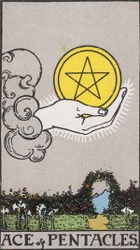 |
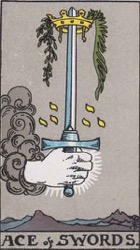 |
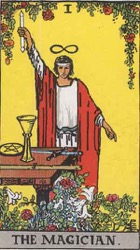 |
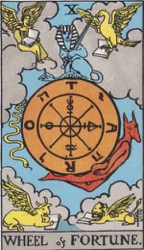 |
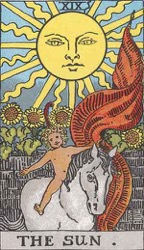 |
© Phuture Me Ltd 2019. All rights reserved.
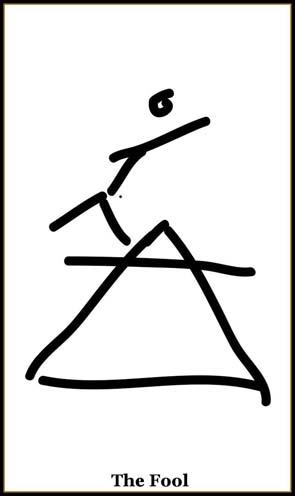
The Fool is probably the most misunderstood but certainly the most important card in the Tarot deck. In the Rider Waite Smith deck, Arthur E. Waite and Pamela Coleman Smith's Fool is illustrated in a way that leaves The Fool's next step open to interpretation. Most who see this card just take his name and, as the human mind is so good at, fill in what's not there. A cliff and unheeded disaster. But is it a cliff? Could it just be a ledge? Is the dog trying to warn him, or is it just happy and carefree like its companion who is looking towards the heavens. The dog too appears, on closer inspection, to be looking in the same direction. Neither traveler is concerned with the ground falling away in front of them.
The Fool is related to the Pages in the Minor Arcana suits. Each minor page relates to a naive, or foolish, approach to their element. The Fool, just like the other Major courtiers (The Chariot, The Empress and The Emperor ), is a master off all the elements with a focus on the spiritual realm. He walks left, towards the past, which is symbolic of the wrong direction. Beautifully dressed he looks as if he has set out on an adventure in search for something. His focus on heaven symbolises his search for a meaning to life, a higher purpose and destiny. His intentions are good but he lacks experience and wisdom and may be going in the wrong direction. The imagery of The Fool asks a question of us. Who are we to look at someone else and think that they are going in the wrong direction? If their intentions are good, and they are following their heart not their head, how can they be wrong? The following 21 cards in the Major Arcana each symbolise the mysteries The Fool must solve, and lessons he must learn, once he finds the life path he must follow that will guide him to what he is looking for.
The Fool is unique among the Major Arcana for being the only card not to have a number. However some Tarot decks give this card a numerical value of 0 (zero). There is no numerology to constrain The Fool and he, and the Pages, are unique in being free from its cycle of numbers. The Fool represents an individual's journey through the trials of life, marked out by each of the 21 Major Arcana cards, ending with the Ascension to Enlightenment in the final card, The World.
Sometimes we need to follow our hearts not our heads or the perceived wisdom of others and trust in our own intuition.
“Your time is limited, so don’t waste it living someone else’s life.
Don’t be trapped by dogma, which is living with the result of other people’s thinking.
Don’t let the noise of other’s opinions drown out your own inner voice.
And most important, have the courage to follow your heart and intuition.
They somehow already know what you truly want to become.
Everything else is secondary.
Stay Hungry, Stay Foolish ”
- Steve Jobs, 2005 Stanford Commencement Address.
© Phuture Me Ltd 2010-2018. All rights reserved.
THE PICTORIAL KEY TO THE TAROT
By Arthur Edward Waite (1911)
With light step, as if earth and its trammels had little power to restrain him, a young man in gorgeous vestments pauses at the brink of a precipice among the great heights of the world; he surveys the blue distance before him-its expanse of sky rather than the prospect below. His act of eager walking is still indicated, though he is stationary at the given moment; his dog is still bounding. The edge which opens on the depth has no terror; it is as if angels were waiting to uphold him, if it came about that he leaped from the height. His countenance is full of intelligence and expectant dream. He has a rose in one hand and in the other a costly wand, from which depends over his right shoulder a wallet curiously embroidered. He is a prince of the other world on his travels through this one-all amidst the morning glory, in the keen air. The sun, which shines behind him, knows whence he came, whither he is going, and how he will return by another path after many days. He is the spirit in search of experience. Many symbols of the Instituted Mysteries are summarized in this card, which reverses, under high warrants, all the confusions that have preceded it.
In his Manual of Cartomancy, Grand Orient has a curious suggestion of the office of Mystic Fool, as apart of his process in higher divination; but it might call for more than ordinary gifts to put it into operation. We shall see how the card fares according to the common arts of fortune-telling, and it will be an example, to those who can discern, of the fact, otherwise so evident, that the Trumps Major had no place originally in the arts of psychic gambling, when cards are used as the counters and pretexts. Of the circumstances under which this art arose we know, however, very little. The conventional explanations say that the Fool signifies the flesh, the sensitive life, and by a peculiar satire its subsidiary name was at one time the alchemist, as depicting folly at the most insensate stage.
Related Tarot Cards
 |
 |
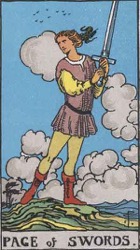 |
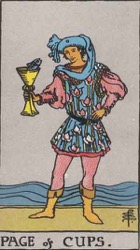 |
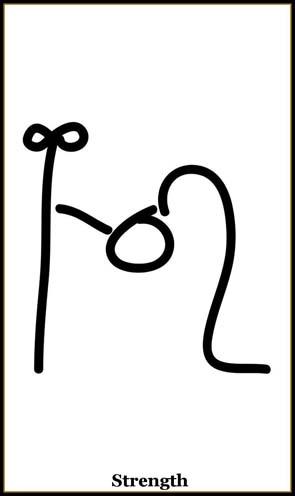
Just over 100 years ago Tarot went through a revolutionary change with the publication of the Rider Waite Smith (RWS) tarot deck. Up until this point the most popular Tarot decks had followed a structure and format based on the Marseilles Tarot. The cards in the Minor Arcana had no pictures and were closer to playing cards with pips than to the fully illustrated deck of cards that the RWS deck introduced. In addition to this radical evolution Waite and Smith also swapped the positions of two of the Major Arcana cards. Prior to the RWS deck Strength was card 11 and card 8 was Justice.
The majority of modern Tarot decks have continued with this altered numbering in the Major Arcana even though the reason Waite gave, which you can read below, was "for reasons that satisfy myself" which doesn't give much insight as to why it was so important to him or Pamela Smith. Tarot has a well ordered structure based on the foundations of the classical elements and numerology. The 8th card of the Major Arcana, according to the symbology of numerology, should have a meaning and interpretation of power and control. For this reason Strength is numerologically better suited to position 8 than Justice. In addition to this Justice as card 11, which reduces to 2 in numerology (1+1=2), links it directly to Judgement which is card 20 and also reduces to 2 (2+0=2). Therefore swapping these cards corrected and improved the overall structure of Tarot significantly.
As with all the cards in Tarot's Major Arcana Strength represents the mastery of the elements in combination with the numerology. It's worth reviewing the cards numbered 8 in the Minor Arcana to understand what it is this card has mastered. The common traits of the number 8 are ambition, discipline, practicality, being realistic and in control. Tarot's Strength card is mental strength (Swords, air and intellectual challenges), emotional strength (Cups, water and emotional issues and needs), physical and/or financial strength (Pentacles, earth and the material including health) and strength of resolve and ambition (Wands, fire and energy).
In the RWS deck the woman depicted in Strength has an infinity symbol placed like a halo above her head. This will be to remind us that the number 8 is an upright infinity symbol and that the laws of karma apply. Any action will have an equal and opposite reaction as the closed looped always returns. She is depicted as using gentle force to open the mouth of the lion. When you are in a position of strength over another remember to treat them as you would want to be treated yourself.
Strength is the card of physical well being, strength of will and controlling the inner beast. Mankind's dominance over the animal kingdom through the use of his superior intellectual strength. Impulsive animal instincts need to be controlled with strength of mind and will. In a very simple interpretation it can represent a pet or animal. Good physical health is a common theme with this card, it often represents good health if health is of concern and a focus in a reading. Surrounding cards will indicate if this health is at risk or how it can be achieved.
© Phuture Me Ltd 2010-2019. All rights reserved.
THE PICTORIAL KEY TO THE TAROT
By Arthur Edward Waite (1911)
A woman, over whose head there broods the same symbol of life which we have seen in the card of the Magician, is closing the jaws of a lion. The only point in which this design differs from the conventional presentations is that her beneficent fortitude has already subdued the lion, which is being led by a chain of flowers. For reasons which satisfy myself, this card has been interchanged with that of justice, which is usually numbered eight. As the variation carries nothing with it which will signify to the reader, there is no cause for explanation. Fortitude, in one of its most exalted aspects, is connected with the Divine Mystery of Union; the virtue, of course, operates in all planes, and hence draws on all in its symbolism. It connects also with innocentia inviolata, and with the strength which resides in contemplation.
These higher meanings are, however, matters of inference, and I do not suggest that they are transparent on the surface of the card. They are intimated in a concealed manner by the chain of flowers, which signifies, among many other things, the sweet yoke and the light burden of Divine Law, when it has been taken into the heart of hearts. The card has nothing to do with self-confidence in the ordinary sense, though this has been suggested--but it concerns the confidence of those whose strength is God, who have found their refuge in Him. There is one aspect in which the lion signifies the passions, and she who is called Strength is the higher nature in its liberation. It has walked upon the asp and the basilisk and has trodden down the lion and the dragon.
Related Tarot Cards
 |
 |
 |
 |
 |
© Phuture Me Ltd 2019. All rights reserved.
Free AI Tarot Reading. Sample the Future!
Artificial Intelligence reads Tarot Cards so well you have to see it to believe it!
We'd love for you to try it for FREE and see for yourself why this excites us.
